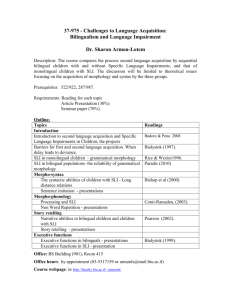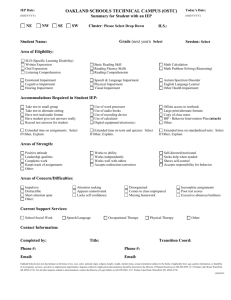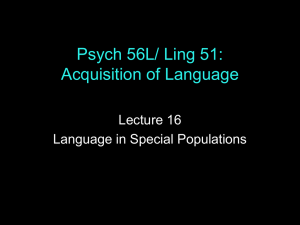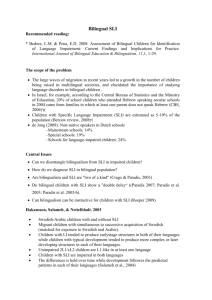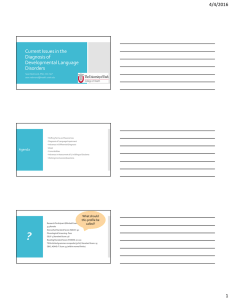924outline11_12
advertisement
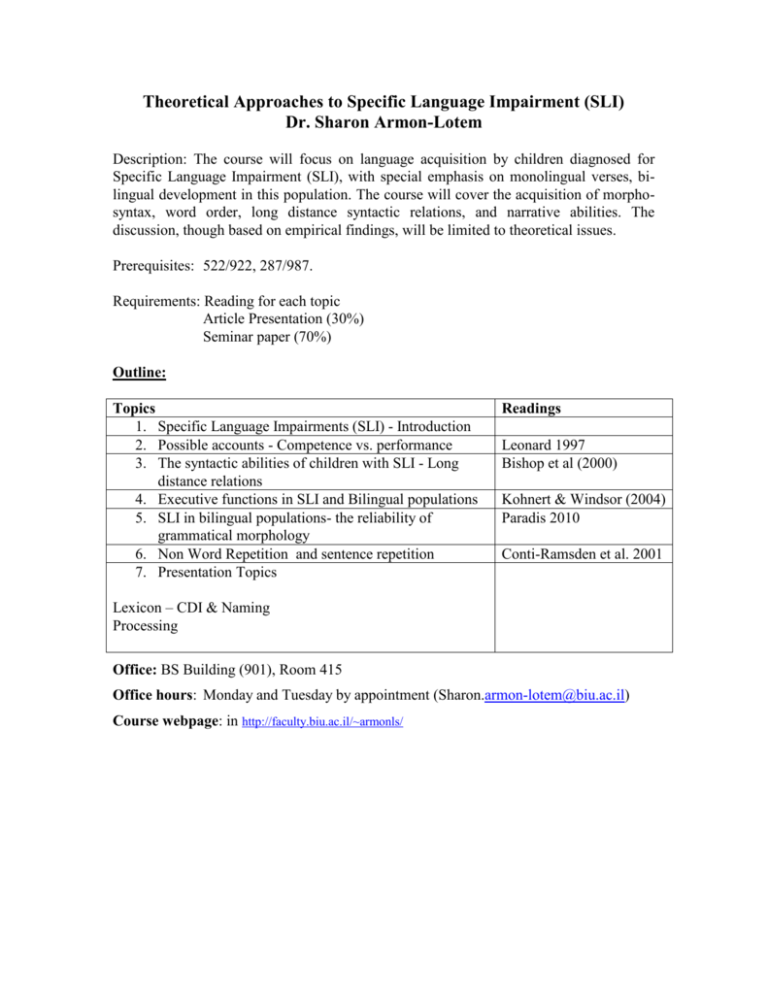
Theoretical Approaches to Specific Language Impairment (SLI) Dr. Sharon Armon-Lotem Description: The course will focus on language acquisition by children diagnosed for Specific Language Impairment (SLI), with special emphasis on monolingual verses, bilingual development in this population. The course will cover the acquisition of morphosyntax, word order, long distance syntactic relations, and narrative abilities. The discussion, though based on empirical findings, will be limited to theoretical issues. Prerequisites: 522/922, 287/987. Requirements: Reading for each topic Article Presentation (30%) Seminar paper (70%) Outline: Topics 1. Specific Language Impairments (SLI) - Introduction 2. Possible accounts - Competence vs. performance 3. The syntactic abilities of children with SLI - Long distance relations 4. Executive functions in SLI and Bilingual populations 5. SLI in bilingual populations- the reliability of grammatical morphology 6. Non Word Repetition and sentence repetition 7. Presentation Topics Readings Leonard 1997 Bishop et al (2000) Kohnert & Windsor (2004) Paradis 2010 Conti-Ramsden et al. 2001 Lexicon – CDI & Naming Processing Office: BS Building (901), Room 415 Office hours: Monday and Tuesday by appointment (Sharon.armon-lotem@biu.ac.il) Course webpage: in http://faculty.biu.ac.il/~armonls/ Articles for the course Reading Bishop, D. V. M., Bright, P., James, C. S., Bishop, J. and H. K. J. Van der lely. 2000. Grammatical SLI: A distinct subtype of developmental language impairment? Applied Psycholinguistics 21, 159–181 Conti-Ramsden, G., Botting, N., & Faragher, B. (2001). Psycholinguistic markers for specific language impairment. Journal of Child Psychology and Psychiatry, 6, 741-748. Kohnert, K., & Windsor, J. (2004). The search for common ground: Part II. Nonlinguistic performance by linguistically diverse learners. Journal of Speech, Language, and Hearing Research, 47, 891-903. Leonard, L. B. (1997) Children with Specific Language Impairment. The MIT Press: 4387 Paradis, J. (2010). The interface between bilingual development and specific language Impairment. Applied Psycholinguistics 31, 227–252 2 Presentations Lexicon I. CDI *Ring, E.D. & Fenson, L. (2000). Assessment of language comprehension and production: Child performance versus parent judgment. First Language, 20, 141159. *Fenson, L., Bates, E., Dale, P., Goodman, J., Reznick, J.S., & Thal, D. (2000). Measuring variability in early child language: Don't shoot the messenger. Child Development, 71, 323-328. Maital, S. L., Dromi, E., Sagi, A. and Bornstein, M. H. (2000) The Hebrew Communicative Development Inventory: language specific properties and crosslinguistic generalizations. Journal of Child Language, 27, 43-67. Thal, D. J., O'Hanlon, L., Clemmons, M. and LS., Fralin (1999) Validity of a Parent Report Measure of Vocabulary and Syntax for Preschool Children With Language Impairment. Journal of Speech, Language, and Hearing Research 42 482-496 Hick, R. F., Joseph, K. L., Conti-Ramsden, G., Serratrice, L. & B. Faragher (2002) Vocabulary profiles of children with specific language impairment. Child language teaching and therapy 18 (2) 2002, 165 - 180 Heilmann, J., Ellis Weismer, S., Evans, J. and C. Hollar. (2005). Utility of the MacArthur–Bates Communicative Development Inventory in Identifying Language Abilities of Late-Talking and Typically Developing Toddlers. American Journal of Speech-Language Pathology, 14, 40-51 II. Naming *Lahey, M., and J. Edwards (1996). Why Do Children With Specific Language Impairment Name Pictures More Slowly Than Their Peers? Journal of Speech and Hearing Research 39 1081-1098 McGregor, K. K., Newman, R. M., Reilly, R.M., and N. C. Capone. (2002). Semantic Representation and Naming in Children With Specific Language Impairment. Journal of Speech, Language, and Hearing Research. 45 998-1014 Gray, S. (2004). Word Learning by Preschoolers With Specific Language Impairment Predictors and Poor Learners. Journal of Speech, Language, and Hearing Research 47 1117-1132 3 Processing *Clahsen, H. 2008. Behavioral Methods for Investigating Morphological and Syntactic Processing in Children. In I. Sekerina, E. Fernández & H. Clahsen, (eds.), Developmental psycholinguistics: On-line methods in children’s language processing. Benjamins: Amsterdam, pp. 1-27. Clackson, K. & H. Clahsen 2011. Online processing of cataphoric pronouns by children and adults: Evidence from eye-movements during listening. In: Danis, N., Mesh, K. & H. Sung (eds.), Proceedings of BUCLD 35. Vol.1, Cascadilla Press: Somerville, MA, pp. 119-1 Veríssimo, J. & H. Clahsen 2009. Morphological priming by itself: A study of Portuguese conjugations. Cognition 112: 187–194 Marinis, T. and van der Lely, H. (2007) On-line processing of wh-questions in children with G-SLI and typically developing children. International Journal of Language & Communication Disorders, 42 (5). pp. 557-582 Marinis, T. and Chondrogianni, V. (2011) Comprehension of reflexives and pronouns in sequential bilingual children: do they pattern similarly to L1 children, L2 adults, or children with specific language impairment? Journal of Neurolinguistics, 24 (2). pp. 202-212 Montgomery, J. W., & Leonard, L. B. (1998). Real-Time Inflectional Processing by Children with Specific Language Impairment: Effects of Phonetic Substance. J Speech Lang HearRes, 41(6), 1432-1443. Montgomery, J. W., & Leonard, L. B. (2006). Effects of Acoustic Manipulation on the Real-Time Inflectional Processing of Children With Specific Language Impairment. J Speech Lang Hear Res, 49(6), 1238-1256 Chondrogianni, V & Marinis, T. (in press). Production and processing asymmetries in the acquisition of tense morphology by sequential bilingual children. Bilingualism: Language & Cognition 4



